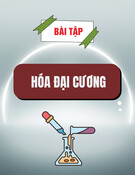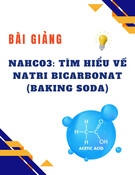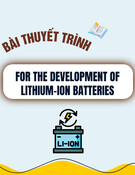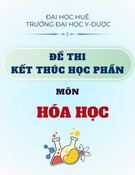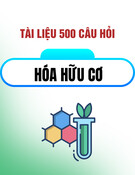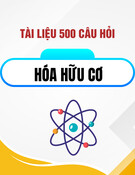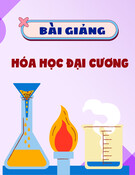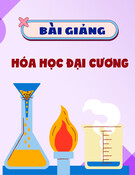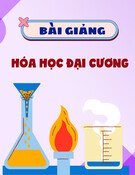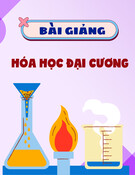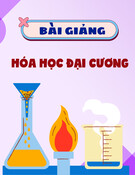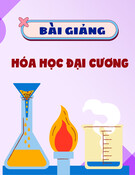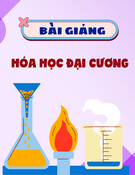
TNU Journal of Science and Technology 230(04): 87 - 94
http://jst.tnu.edu.vn 87 Email: jst@tnu.edu.vn
CURRENT STATUS OF USING STORIES, COMICS, AND CARTOONS
IN TEACHING CHEMISTRY IN THE DIRECTION OF DEVELOPING
STUDENTS’ CREATIVE PROBLEM-SOLVING COMPETENCE
Nguyen Van Dai*, Dao Thi Viet Anh, Kieu Phuong Hao
Hanoi Pedagogical
University 2
ARTICLE INFO ABSTRACT
Received:
21/11/2024
Education in Vietnam has entered a period of innovation towards
developing learners' attributes and competencies. Finding measures to
develop competence in general and creative problem-
solving
competence in particular for students in high schools is necessary in
the current context. Stories, comics, and cartoons are entertaining
products that can be used to convey learning content to students
gently and engagingly. This article presents the content and method of
surveying 1191 students and 122 teachers to clarify the current
situation of using stories, comics, and cartoons in teaching chemistry
in high schools. The survey results have shown that using these
learning tools in teach
ing chemistry has practical significance,
contributing to developing creative problem-
solving competence and
enhancing students' interest in learning chemistry in the current
educational period.
Revised:
04/3/2025
Published:
04/3/2025
KEYWORDS
Stories
Comics
Cartoons
Creative problem-solving
competence
Chemistry
THỰC TRẠNG SỬ DỤNG TRUYỆN, TRUYỆN TRANH VÀ PHIM HOẠT HÌNH
TRONG DẠY HỌC HÓA HỌC THEO HƯỚNG PHÁT TRIỂN NĂNG LỰC
GIẢI QUYẾT VẤN ĐỀ VÀ SÁNG TẠO CHO HỌC SINH
Nguyễn Văn Đại
*
, Đào Thị Việt Anh, Kiều Phương Hảo
Trư
ờ
ng Đ
ạ
i h
ọ
c Sư ph
ạ
m Hà N
ộ
i 2
THÔNG TIN BÀI BÁO TÓM TẮT
Ngày nhận bài:
21/11/2024 Giáo dục ở Việt Nam đã bước vào giai đoạn đổi mới theo hướ
ng phát
triển năng lực và phẩm chất cho người học, việc tìm ra các biệ
n pháp
để phát triển năng lực nói chung, năng lực giải quyết vấn đề
và sáng
tạo nói riêng cho học sinh ở trường phổ thông là cần thiết trong bố
i
cảnh hiện nay. Truyện, truyện tranh, phim hoạt hình là những sả
n
phẩm mang tính giải trí cao và có thể được sử dụng để truyền tả
i các
nội dung học tập đến học sinh một cách nhẹ nhàng và hấp dẫn. Bà
i
báo này trình bày nội dung và phương pháp khảo sát 1191 họ
c sinh
và 122 giáo viên nhằm làm rõ thực trạng sử dụng truyện, truyệ
n tranh
và phim hoạt hình trong dạy học hóa học ở trường trung học phổ
thông. Kết quả khảo sát cho thấy việc sử dụng các công cụ
này trong
dạy học hóa học có ý nghĩa thực tiễn, góp phần phát triển năng lự
c
giải quyết vấn đề và sáng tạo, nâng cao hứng thú học tập của họ
c sinh
trong giai đoạn giáo dục hiện nay.
Ngày hoàn thiệ
n:
04/3/2025
Ngày đăng:
04/3/2025
TỪ KHÓA
Truyện
Truyện tranh
Phim hoạt hình
Năng lực giải quyết vấn đề và
sáng tạo
Hóa học
DOI: https://doi.org/10.34238/tnu-jst.11577
* Corresponding author. Email: nguyenvandai@hpu2.edu.vn

TNU Journal of Science and Technology 230(04): 87 - 94
http://jst.tnu.edu.vn 88 Email: jst@tnu.edu.vn
1. Introduction
Our country's education is in a period of fundamental and comprehensive innovation.
Resolution 29-NQ/TW of the Party Central Committee (Tenure XI) oriented: "The revolution in
educational methods must focus on learners, training and developing the competence to solve
problems dynamically, independently and creatively right in learning at general schools" [1].
Since then, creative problem-solving competence has been identified as an important competence
that needs to be formed and developed for students in high school.
Stories, comics, and cartoons are highly entertaining products. Stories are often engaging due
to their content, plot, and narration. Comics are even more engaging as they combine vivid
visuals with concise dialogue. Cartoons have the added advantage of integrating images,
movement, and sound at a pace that enhances the conveyance of action and emotion while also
being more accessible to a broader audience. If they are used to convey learning content
appropriately, they will stimulate interest, positivity, and initiative and improve students' learning
outcomes. In particular, creating stories, comics, and cartoons based on real-life situations will
create opportunities for students to apply knowledge to solve practical problems creatively, while
also contributing to meeting the interests and strengths of many students with artistic tendencies.
Several authors have studied the issue of using stories in teaching chemistry. Rebecca and
Audrey [2], Erika and Kari [3], Collins et al. [4] have studied and pointed out the benefits of
using short stories in teaching, proposed some measures to integrate short stories into chemistry
lessons and how to evaluate the effectiveness of the proposed measures. In Vietnam, Duong [5]
and Tran [6] studied the content of stories about chemistry, and Duong [7] proposed using short
stories in teaching chemistry.
The use of comics and cartoons in teaching chemistry has been studied by several authors
such as Oktapianti [8] who studied the design of a set of comics on thermochemistry as self-study
materials for 11th-grade students and affirmed that comics can be a tool to improve the
participation and teaching process of both teachers and students. Thai and Phan [9] proposed 4
principles and a 6-step process to design cartoons to support teaching Natural Science in grade 9
and initially pointed out the effectiveness of using cartoons on the formation of knowledge
structures and learning interest of students.
Thus, there are few studies on using stories, comics, and cartoons in teaching chemistry.
Initially, there was research on the current situation of the above problem at the Kindergarten
level in a narrow range [10]. Therefore, in this study, we aim to study and evaluate the current
situation of using stories, comics, and cartoons in teaching Chemistry in high schools today to
answer the question: Does the use and organization of activities of creating stories, comics, and
cartoons in Chemistry have practical significance in current general education?
2. Methodology
The purpose of this survey is to clarify the current situation of using stories, comics, and
cartoons in teaching chemistry in high schools to have a basis for proposing some measures to
use these tools in teaching to develop creative problem-solving competence for students.
The survey was conducted on 1191 students and 122 Chemistry teachers in 18 high schools in
some provinces and cities in the North: Hanoi, Thai Binh, Hai Duong, Bac Ninh, Bac Giang,
Hung Yen, Nam Dinh, Hai Phong, Quang Ninh, Vinh Phuc, Phu Tho, Tuyen Quang, Lao Cai.
We used quantitative research methods through survey forms for teachers and students
(directly via printed forms and online via Google Forms). The number of students and teachers is
relatively evenly distributed across high schools in provinces, as well as in rural and urban areas,
to ensure that the data is representative. Data were collected and processed using Excel software.
The survey content for students includes their attitudes towards Chemistry, their attitudes
towards stories, comics, and cartoons, and their ability to create stories, comics, and cartoons; the

TNU Journal of Science and Technology 230(04): 87 - 94
http://jst.tnu.edu.vn 89 Email: jst@tnu.edu.vn
level of their support for the use of stories, comics, and cartoons in teaching chemistry; and the
level of expression of their creative problem-solving competence in Chemistry.
The survey content for teachers includes their perceptions of the manifestations of creative
problem-solving competence of students; their teaching and assessment methods in Chemistry;
and their level of use and ability in creating stories, comics, and cartoons in teaching chemistry.
3. Findings and discussion
3.1. Student survey results
- About attitude towards Chemistry:
Figure 1. Students' attitudes towards Chemistry
The data in Figure 1 shows that the percentage of students who like and really like Chemistry
is still low (37%). The reason is that many students think that Chemistry has a lot of difficulty in
understanding and remembering knowledge (75.5%), has little connection with reality (52.2%)
and the organization of teaching is not attractive (55.6%). In addition, some students also said
that when learning Chemistry, they have to remember many formulas, and complex calculation
problems and do not have many opportunities to practice, so they do not like this subject.
Therefore, to enhance students' interest in learning Chemistry, teachers must actively connect the
knowledge of the lesson with reality and use different teaching tools and forms to attract students.
For that reason, using stories, comics, and cartoons with practical content or organizing students
to compose and design these products will have the opportunity to meet this requirement of
current teaching.
- About attitudes towards stories, comics, and cartoons:
Figure 2. Students' attitudes toward stories, comics, and cartoons
The result in Figure 2 shows that many students are interested (like and really like) in reading
stories (45.09%), reading comics (51.05%) and watching cartoons (58.27%), especially stories,
comics and cartoons containing elements such as fiction (fictitious characters, 54.74%), reality
(solving problems in practice, 49.03%), science (containing scientific knowledge, 47.61%) and

TNU Journal of Science and Technology 230(04): 87 - 94
http://jst.tnu.edu.vn 90 Email: jst@tnu.edu.vn
humor (45.59%). This shows the current trend of students accessing information and the factors
that need to be focused on in creating stories, comics, and cartoons for students.
- About the frequency of creating stories, comics, and cartoons in studying Chemistry:
Figure 3. Frequency of students' creating stories, comics, and cartoons
The data in Figure 3 shows that most students have never participated in creating stories
(71.87%), comics (76.91%), and cartoons (88.83%). This proves that these activities have not
been organized much in the learning process in general and in Chemistry. Besides, some students
have carried out these activities, but mainly based on their interests and strengths, not based on
the learning needs of the subject or the requirements of the teacher.
- About students' ability to create stories, comics, and cartoons:
Figure 4. Students' ability to create stories, comics, and cartoons
Figure 4 shows that many students have average or higher ability in creating stories (59.44%),
comics (50.13%), and cartoons (43.66%). Many students know some software tools for designing
comics and cartoons such as Canva, Medibang, Ibis Paint, PaintToolSAI, Picsart, and Adobe
Illustrator,... and said that they can design with the software when introduced and guided. This
shows the students' information technology ability and proves that teachers can organize these
activities for students in practice.
- About the level of support for the use of stories, comics, and cartoons in teaching Chemistry.
Figure 5. Students' level of support for the use of stories, comics, and cartoons
The data in Figure 5 shows that the majority of students expressed their support (like and really

TNU Journal of Science and Technology 230(04): 87 - 94
http://jst.tnu.edu.vn 91 Email: jst@tnu.edu.vn
like) for using stories, comics, and cartoons (60.28%) or organizing students to create their own
stories, comics, and cartoons in Chemistry (52.39%). This proves that if teachers organize these
activities in chemistry teaching, it can meet the needs, interests, and strengths of many students.
- About students' learning activities in Chemistry:
Table 1. Frequency of students' learning activities
Order
Activity Frequency
Never Seldom Sometimes Frequently
1
Propose practical situations.
27.04
33.59
33.17
6.21
2 Identify problems to be solved in practical
situations.
22.92 29.3 37.87 9.91
3
Propose solutions to solve practical problems.
23.34
30.81
35.35
10.5
4 Plan and implement practical problem-solving
in groups.
25.52 30.48 35.1 8.9
5 Propose new ideas in solving and presenting
practical problems.
26.78 34.17 32.41 6.63
6 Collect comments and suggestions on the results
of solving practical problems.
23.17 26.53 36.94 13.35
7 Evaluate the results of solving practical
problems according to the set criteria.
25.27 31.99 34.01 8.73
8 Adjust the results of solving practical problems
after receiving comments and evaluations.
23.43 28.46 35.1 13.01
The activities listed in Table 1 reflect the manifestations of the creative problem-solving
competence of students. The survey results in Table 1 show that the implementation of the
learning activities is not frequent, especially in proposing practical situations (6.21%), giving
new ideas in solving and presenting practical problems (6.63%), evaluating problem-solving
results according to criteria (8.73%), planning and implementing practical problem-solving in
groups (8.90%). Therefore, to develop these skills, teachers need to increase the assignment of
cooperative tasks to students to find practical situations related to the lesson and create based on
those practical situations, and at the same time provide specific evaluation criteria for these
learning tasks.
- About the level of students' learning skills:
Figure 6. Level of students' learning skills
Figure 6 shows that the rate of students self-assessing their skills (corresponding to the
manifestations of students' creative problem-solving competence) at the fair and good levels is
not high, especially the manifestations such as proposing practical situations (27.8%), giving new

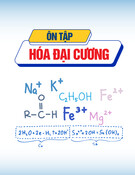
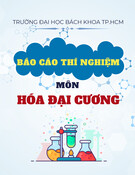
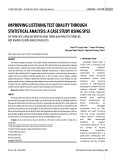

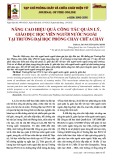
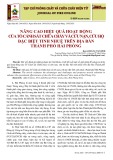
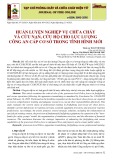
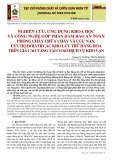


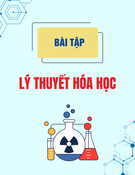
![Đề thi kết thúc học phần Nguyên lí Hóa học 2 [mới nhất]](https://cdn.tailieu.vn/images/document/thumbnail/2025/20251014/anhinhduyet000/135x160/69761760428591.jpg)
